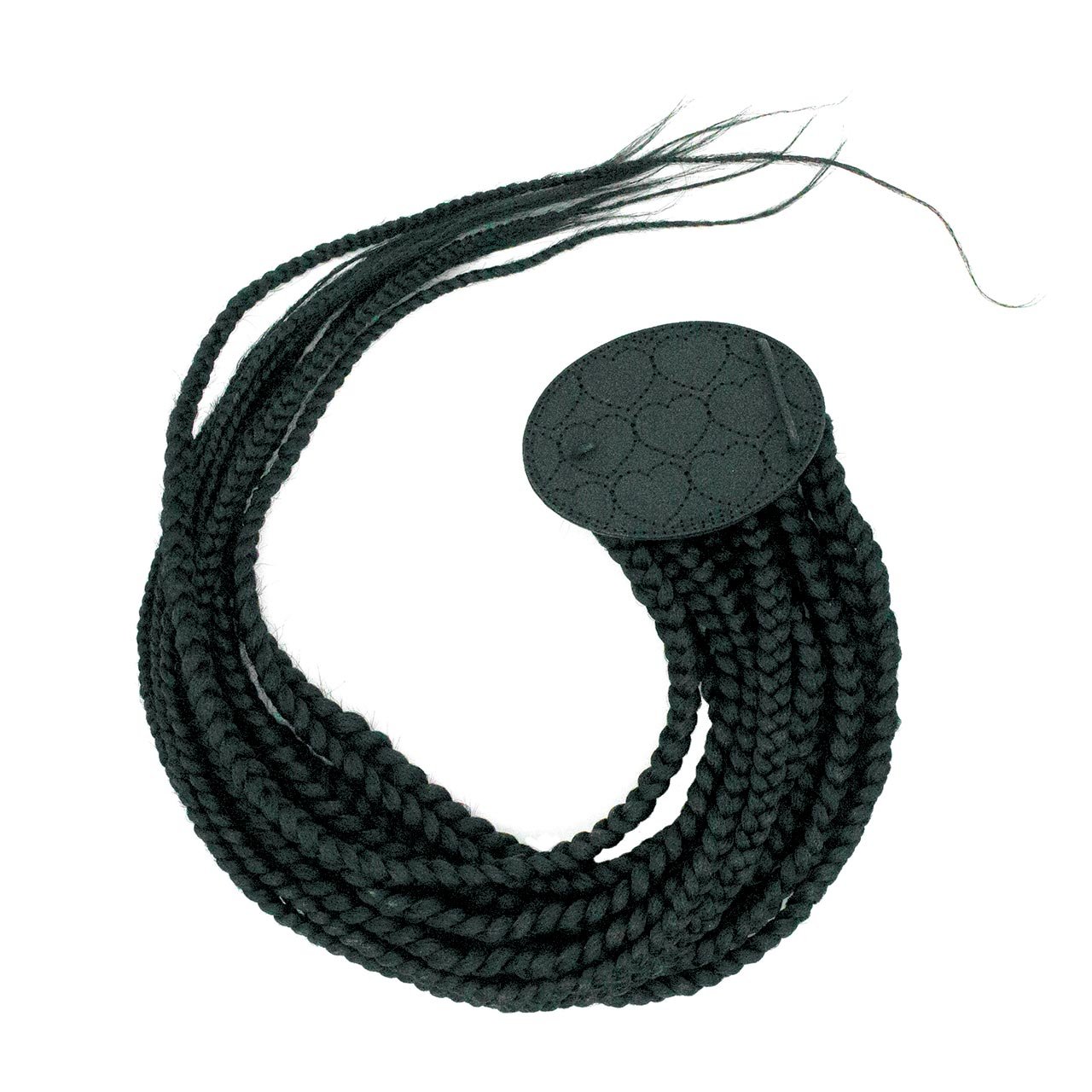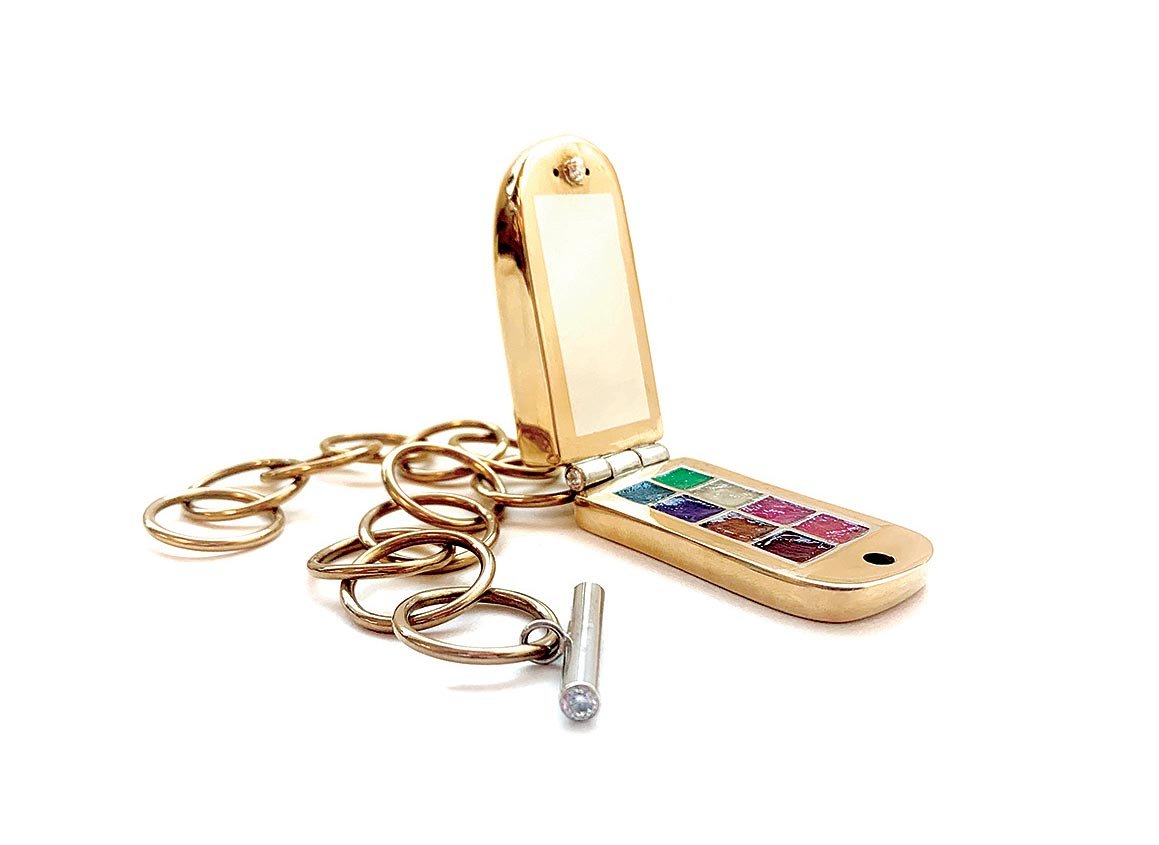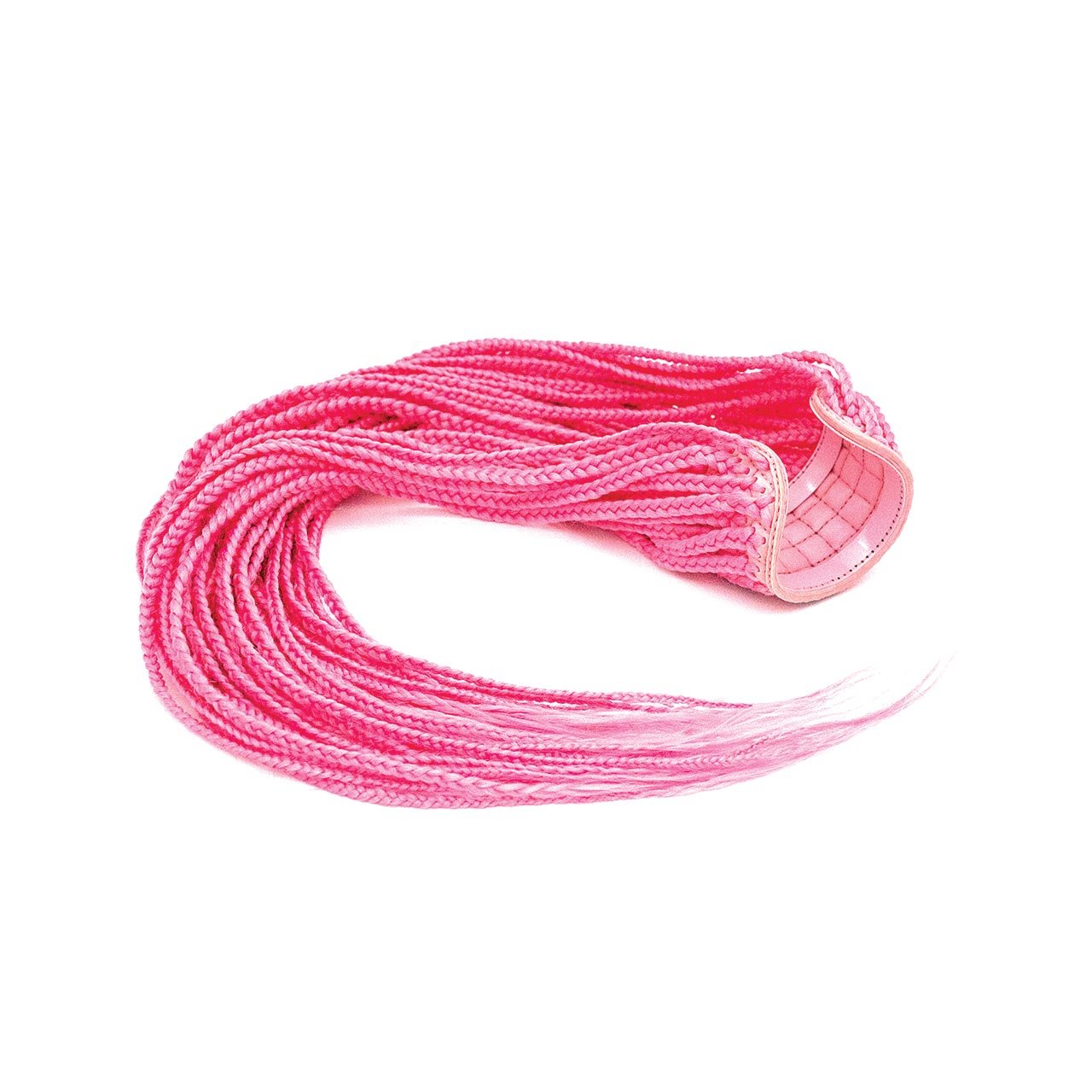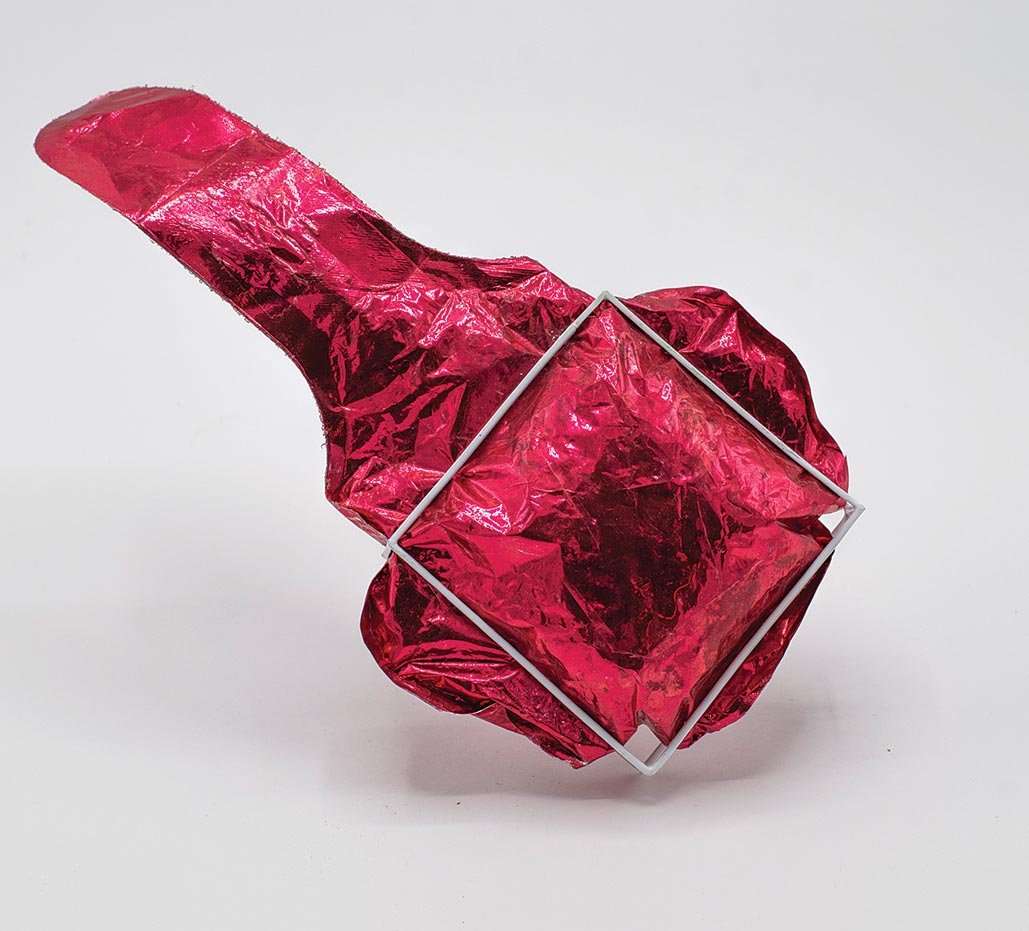Queerphoria Volume 43.3
Photographs courtesy of the artists, except where noted.
MANY FACES by Andrew Thornton of copper, shell cameo, coral, fine silver, mother of pearl, 7.6 x 5.1 x 0.6 centimeters, 2022.
When SULO BEE heard J Taran Diamond share the story of how they became a metalsmith, tears flowed. Diamond explained, in an online panel discussion, that seeing BEE’s work years ago helped motivate them to change their academic focus from “just another STEM degree” to pursuing art and working with metal, “because it was the first time I’d seen a person who was very visibly queer and very visibly not a part of the normative culture being taken very seriously and respected, and I think that really changed my understanding of what was possible for myself.” The revelation of this connection came about shortly after the opening of “[queerphoria]”, a virtual exhibition featuring the work of twenty queer metalsmiths, including Diamond. The exhibition is curated by BEE and Tracey Carswell, co-founders, along with Sol Diaz, of Queer Metalsmiths, a new community that “honors, centers, and uplifts 2SLGBTQIA+ jewelers and metalsmiths.”
“[queerphoria]” follows on the heels of “{Queer} + {Metals}”, a project that included an exhibition in early 2022 during the Ferrous Festival in Hereford, England, and a digital residency at Craftspace in Birmingham, England, by Rebekah Frank, a metalsmith based in San Francisco. When Frank moderated the panel for “[queerphoria]” that included Diamond, she acknowledged that the term queer is “sticky,” and used in multiple ways—to describe politics, to describe identity, as a theoretical framework for art, as a slur—and that while it certainly is not the defining aspect of each artist’s life or work, it is an often unavoidable topic in contemporary culture. For “{Queer} + {Metals}”, Frank began with a survey of queer artists, asking them four open-ended questions about metalsmithing, queerness and other ways they identify themselves. In her related essay, she wrote, “The variety of responses, the diversity of intersectional identities that complicate any sense of the singularity of queerness, and the perspectives that shifted based on region, age, and sense of safety were big takeaways from this project… this project is a beginning, a promise of things to come.”
“[queerphoria]”, which opened during New York City Jewelry Week 2022, shares that sense of promise and similarly includes a series of questions to the artists: What does “queerphoria” mean to you? What does being queer mean to you in relation to your material choices? What role does your studio practice play in your identity? When creating your work, do you consider the relationship your object has with the viewer? What is one thing you would like to share? The call for entries was open to all 2SLGBTQIA+ artists working with metal, and artists were allowed to submit applications anonymously. The online exhibition begins with an array of pictures of the artists against a bright, mottled background. Clicking “view” below each artist’s name takes visitors to their individual pages, all with a brief biography, artist’s statement, images of their work, and answers to the five questions. Their replies are engrossing, revealing, thoughtful, vulnerable, often charming, and sometimes painful. The emphasis is on the artists’ words more than on their work, but the format provides plenty of links for further explorations of what each creates.
I’M SAFE IN HERE BROOCH by Esteban Erosky of enamel on copper, painted polycarbonate, aluminum, hot enamel on hammer formed copper. 16.5 x 5.5 x 1.0 centimeters, 2022.
The first question, about what “queerphoria” means, elicited the most moving responses. Many of the answers are awash with a fervent desire to be asked not about the hardships of being queer, but about the joys. Andrew Thornton replied simply, “Queerphoria is freedom. It is a freedom to be myself and express myself the way that I see myself.” Esteban Erosky, a Mexican-born artist living in Spain, similarly stated, “Queerphoria is a feeling of total freedom, of being able to play a role in this world and in this society without thinking about labels or pronouns.” Caio Mahin, a Brazilian artist based in Germany, shared a childhood moment in his response: “all I can think about is the joy I used to feel as a kid when [sneaking] into my mother’s closet to try on her jewelry and makeup. Looking at myself in the mirror and finding me was easily possible by ornamenting my body.” As Shaunia Grant explained, “Accepting my queerness was one of the most rewarding experiences of my life. The beauty of living an openly queer life could only be described as euphoric.”
For many of the artists, the idea of “queerphoria” centers on community. Steven KP, whose work features carved knots in wood, explained that for him, “queerphoria brings to mind the unique place of *joy* that chosen communities can cultivate.” Grey Von Cannon expresses the power of this connection through her materials, as in her enamel and copper foil Just Enough earrings, which are made of delicate elements that become strong when combined. She explained, “I have always compared that bond to my relationship with other queer artists. We all show up as vulnerable and fragile beings, but we come together in a way that makes us stronger and more confident to be ourselves.” Robert Thomas Mullen added, “queerphoria, to me, is the warm feeling I get wearing another queer artist’s work…”
A couple of the artists addressed history in discussing queerphoria. Adam Atkinson provided an overview of legal issues: “Feeling joy in one’s queerness is a story of resistance to adversity. Queer social movements, such as the Gay Liberation Front of the 1960s-70s, propelled LGBTQIA+ issues to the forefront of American politics, ultimately helping to end the anti-sodomy laws in 2003 (Lawrence v. Texas) and legalizing same-sex marriage in 2015 (Obergefell v. Hodges). These victories marked significant gains for LGBTQIA+ rights, and yet many battles continue to be hard-fought. With the overturning of Roe v. Wade came a wave of homophobic, anti-trans laws banning health care and visibility for queer individuals.” Matt Lambert approaches history as an opportunity, mining archives and similar resources to find “new understandings and possibilities”—chances to bring attention to the parts of history that have been hidden or unwritten. One of their ongoing works is a collaborative multimedia performance titled SPIT with Carl Olof Berg that began at the Royal Armoury in Stockholm. Billed by the museum as a “digital queer performance,” the initial iteration of SPIT took place in its historic galleries and investigated “saliva in relation to the body and its existence within archive, document, choreography and objects.” Berg and Lambert donned headlamps tilted to illuminate their faces and masks dripping with colorless glass baubles and crystals. Part of the project involved the museum streaming the sounds of the two spitting, drooling and swallowing to encourage visitors to consider the bodies that once interacted with the historic objects that are on display.
RELIEF LINE WITH SPACE HORIZONTAL NECKLACE by Steven KP of ebonized carved cherrywood, deerskin leather, oxidized sterling silver, 53.3 x 5.1 x 2.5 x 63.5 centimeters, 2022.
SPIT INSTALLATION DOCUMENTATION inside the Royal Armoury, collaboration with Carl Olof Berg, 2022. Photograph by Jennifer Drotz Ruhn.
One theme that emerged in response to the question about materials was the idea of finding worth in what has been unvalued or discarded by society. Hannah Reynoso Toussaint addressed this directly, writing, “I often reclaim or reuse materials that I find or manipulate in some way to make them work with my piece. This relates to society historically viewing queers as ‘cast offs,’ and forcing us to find and make our own queer joy.” (Her playful Saccharine Dreams necklace includes found chain and slices of luffa.) Shaunia Grant shared how being queer has shaped her perspective on materials: “Queerness has allowed me to understand the world around me in an alternative way. When uprooting expectations of sexual identity and gender, it becomes much easier to do the same with materials... Something that was once tossed aside becomes the center point of a work.”
Canadian artist Danica Drago raised the issue of jewelry carrying “historical and cultural connotations that reinforce the idea that our bodies are bound by binary structures,”—the convention that there are certain types of jewelry for men and certain types for women—and seeks to upend that idea through their jewelry. In particular, they have been working with sponge, a natural, porous material that for Drago “relates to [their] trans/non-binary body.” Drago notes that society has historically used the language of science to emphasize the idea of a biological gender binary, but that they are using science to draw attention to nature’s inherent fluidity. For their PB. XYXXYXYYXY brooch, they carved natural sponge, saturated it with colored clay, and then used a burnout technique to remove the organic material. The necklace is part of Drago’s Porous Binaries series, which they describe as “an exploration of materials and identities in flux.” Mercury Swift similarly references nature and science in their work to highlight non-binary beauty.
Many of the artists in the exhibition experience otherness in multiple ways. Several are immigrants, while a few mentioned their neurodivergence, including Newell Catania, who wrote, “My practice has recently strayed from perfectionism, becoming an exploration of neurodivergence, collection, and compulsion.” Others discussed being separate from the art jewelry world or being of an ethnic or racial minority.
THEY, THEM, THEIRS by Vee Miller of 20G brass sheet, Herkimer Diamond, hand fabricated brass letters, 3 finger ring, 2022.
Vee Miller, of BlackQueerMagic, is the only self-taught metalsmith in the exhibition. During the panel moderated by Frank, she revealed that growing up—she was born in Jamaica and experienced foster care—she was not aware that studying jewelry in school was even a possibility. When she first began making jewelry, she did wire wrapping, but was rejected by the jewelry establishment. She stated, “there are a lot of black people that wire wrap, that use that particular process/practice as a form of creativity, as a form of spiritual upliftment…creating pieces that make them feel beautiful and adorned,” and lamented that society often disparages those accomplishments. Miller is also a social advocate and licensed clinician, and she uses those activities and her now amplified voice as a metalsmith in support of Black and queer communities—likening her efforts to the metalbenders in the animated television series Avatar: The Last Airbender who use their special skills to create their own world.
Shaunia Grant, who is from the border town of Las Cruces, New Mexico, identifies as indigenous and Latinx. In her work, she gathers the consumer leftovers of a typical American birthday party, or makes them herself, to express her sadness that the traditions of her Mexican and indigenous heritages are being replaced by a “hollow version of conformity.” Her work is filled with cheerful colors and echoes of festivity, but the candles are extinguished, the balloons deflated, and everything is uncomfortably off. In her Balloon Brooch II she positions part of the crinkly red mylar in a white square, with the edges of the balloon extending uselessly beyond the frame.
J Diamond’s work in the exhibit focuses on braided synthetic hair extensions. For Diamond, this material is adornment, a token of femininity, about display, and a sign of Blackness and queerness. They wrote, “the braiding of afro-textured hair serves, both in this work and in the cultural practices that this work references, as a means of self-transformation that exists uniquely within blackness.” Through this work, they “address the ways in which the visual cues often associated with queerness intersect with the visual aesthetics of blackness, where hair occupies a space somewhere between body and ornament.” Diamond sometimes works with hair that is black, but often they select campy colors, as in their Limp Wrist bracelet with its vibrant pink braids. Diamond treats their materials with dignity, and, like their peers, embraces and elevates otherness.
“Funlola Coker, an immigrant from Lagos, Nigeria, who now lives in New Paltz, New York, stated, ‘as queer metalsmiths, we present new and alternative lenses of viewing the world. To me, it is not always about working in opposition to what already exists in our field, but asserting the beauty and complexity of otherness.’ ”
When asked about the relationship between the work they create and the viewers of that work, the artists gave a range of answers. Diamond thinks of theirs as “tools… to signal the wearer’s queerness to the viewer.” Adam Atkinson considers his audience as bifurcated: half can appreciate his work simply for its aesthetics (“its craft, construction, and materiality”), while those “in the know” might don the pieces “like a badge or symbol of inclusion,” aware that the organic forms, pierced elements and furry textures reference “the many orifices of the human body.” Robert Thomas Mullen creates quiet, beautifully crafted work—like his Floral Brooch with dried flowers set in silver behind mineral crystal [or his Pebble Brooch with its dark Icelandic stones and opal set in silver]—that he does not consider as “outwardly queer,” hoping instead that wearers and viewers appreciate “the care that has been taken with every choice.”
Several participants shared some of the challenges they have faced as queer individuals. Tyler Young stated that he struggled with expressing his identity for most of his life. Caio Mahin raised the issue of his father’s internalized homophobia and violent reaction to Mahin’s desire to have his ears pierced as a youth. Mercede Sheybani, a graduate student in California, brought attention to an issue in her home country of Iran: two women, Zahra Seddiqi Hamedani and Elham Choubdar recently were condemned to death because of their support of 2SLGBTQIA+ rights. Sheybani’s work in the exhibition, titled Let’s stop gendering things that do not have a gender Armour, is of two parts that can be laced together and worn as a top or hung side-by-side on a wall. In Armour, she alternates diamonds of denim (secretly sandwiching layers of pink and blue felt) and metal with raised images of popular toys. The toys she preferred as a child are in silver while the others are in bronze. She explains, “Each silver part has meaning to me. Feminine gendered toys are in front, and masculine gendered toys are in back,” and most of her favorite hobbies and toys are in back. She adds, “as an Iranian girl, I was not allowed to have them… Florida’s ‘don’t say gay’ law reminded me of those dark days in my childhood.”
“BIG BLACK” by J Taran Diamond of braiding hair, silicone, brass, powder coat, thread; quilted silicone, 10.2 x 40.6 x 2.5 centimeters, 2022. GIRL’S PRINCESS BLING FLIP PHONE LIP GLOSS SET FOR GIRLS by Newell Catania of bronze, sterling silver, cubic zirconia, petroleum jelly, mica, apple fragrance oil, 3.8 x 7.6 x 3.8 centimeters, 2022. LIMP WRIST by J Taran Diamond of braiding hair, dyed silicone, steel, powder coat, thread, 71.1 x 8.9 x 7.6 centimeters, 2022. BALLOON BROOCH II by Shaunia Grant of mylar balloon, brass, powder coat, 5.1 x 10.2 x 2.5 centimeters, 2021.
Funlola Coker, an immigrant from Lagos, Nigeria, who now lives in New Paltz, New York, stated, “as queer metalsmiths, we present new and alternative lenses of viewing the world. To me, it is not always about working in opposition to what already exists in our field, but asserting the beauty and complexity of otherness.” “[queerphoria]” is a compelling exhibition filled with honesty, urgency and sweetness, and, of course, jewelry and other art. It provides an opportunity to better understand contemporary jewelry and better appreciate contemporary artists through revealing the perspectives and experiences of queer makers. The curators explain, “Our focus for ‘[queerphoria]’ is to uplift the work and the words at the same time, having viewers see past perceiving the work as just a visually pleasing object, connecting with the concepts and thoughts of queer makers behind the work.”
The curators’ final question, of what else the artists would like to share, garnered many brief replies with delightful personal details: Adam Atkinson’s favorite tool is a small riveting hammer he made from a chopstick and a nail, Danica Drago is obsessed with their “gremlin baby-cat named Mona,” Steven KP provides regular updates about his Dachshund named Finnegan on Instagram, Funlola Coker likes to bake, J Diamond recommends SYRO for queer and gender non-conforming shoes, and L M deLeon makes and performs with skeleton puppets. The answers also included praise and admiration for the exhibit, with Alexandra Ferreira (a Portuguese graduate student in London) describing it as a safe space that “reinforces creative expression as an act of resistance against oppressive structures, which is vital for queer survival and safety,” while Esteban Erosky gushed, “events like these give me peace for all that they mean! love you!”
We hope to foster dialogue and understanding around the expressions of identity used in this article. To that end, we provide these two resources towards understanding these terms:
Wamsley, Laurel. “A Guide to Gender Identity Terms,” NPR, June 2, 2021, https://www.npr.org/2021/06/02/996319297/gender-identity-pronouns-expression-guide-lgbtq
“What Does 2SLGBTQIA+ Mean?,” OK2BME.ca, https://ok2bme.ca/resources/kids-teens/what-does-lgbtq-mean/
SUGGESTED READING
Exhibition website: https://www.queermetalsmiths.com/queerphoria
[queerphoria]: A Panel Discussion on Queerness and Euphoria, https://www.youtube.com/watch?v=EPo7MaygO2I
Frank, Rebekah. “Queer + Metals: Shaped by Us,” https://www.rebekahfrank.com/queer-metals-essay
LET’S STOP GENDERING THINGS THAT DO NOT HAVE A GENDER ARMOUR by Mercede Sheybani of silver, bronze, found objects, denim, felt, and bronze wire, 2021.
MENDED HEART NECKLACE by Caio Mahin of camellia wood, oxidized silver and magnet, 20.0 x 20.0 x 1.0 centimeters, 2020. Photograph by Pierre Primetens.
Ashley Callahan is an independent scholar and curator in Athens, Georgia, with a specialty in modern and contemporary American decorative arts. She has an undergraduate degree from Sewanee and a master’s degree in the history of American decorative arts from the Smithsonian and Parsons. The University of Georgia Press recently published her book Frankie Welch’s Americana: Fashion, Scarves, and Politics. She is also the author of Southern Tufts: The Regional Origins and National Craze for Chenille Fashion (UGA Press, 2015) and co-author of Crafting History: Textiles, Metals, and Ceramics at the University of Georgia (Georgia Museum of Art, 2018). The former two books touch on subjects previously covered in Ornament Volumes 35, No. 1 and 39, No. 3. Callahan enjoys every opportunity to learn about, talk about, wear(!), and write about contemporary jewelry. She was especially honored to write about “[queerphoria]” and enjoyed getting to know this group of artists through the exhibition and their online presences. They can each now count her as a fan.












